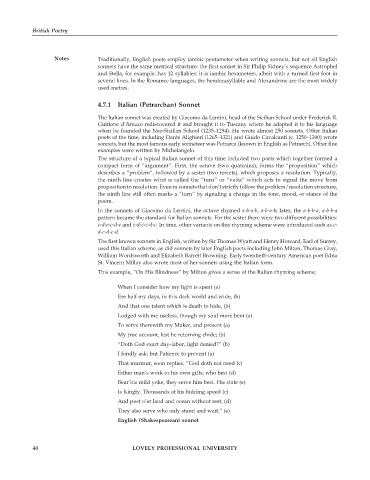Page 47 - DENG405_BRITISH_POETRY
P. 47
British Poetry
Notes Traditionally, English poets employ iambic pentameter when writing sonnets, but not all English
sonnets have the same metrical structure: the first sonnet in Sir Philip Sidney’s sequence Astrophel
and Stella, for example, has 12 syllables: it is iambic hexameters, albeit with a turned first foot in
several lines. In the Romance languages, the hendecasyllable and Alexandrine are the most widely
used metres.
4.7.1 Italian (Petrarchan) Sonnet
The Italian sonnet was created by Giacomo da Lentini, head of the Sicilian School under Frederick II.
Guittone d’Arezzo rediscovered it and brought it to Tuscany where he adapted it to his language
when he founded the Neo-Sicilian School (1235–1294). He wrote almost 250 sonnets. Other Italian
poets of the time, including Dante Alighieri (1265–1321) and Guido Cavalcanti (c. 1250–1300) wrote
sonnets, but the most famous early sonneteer was Petrarca (known in English as Petrarch). Other fine
examples were written by Michelangelo.
The structure of a typical Italian sonnet of this time included two parts which together formed a
compact form of “argument”. First, the octave (two quatrains), forms the “proposition” which
describes a “problem”, followed by a sestet (two tercets), which proposes a resolution. Typically,
the ninth line creates what is called the “turn” or “volta” which acts to signal the move from
proposition to resolution. Even in sonnets that don’t strictly follow the problem/resolution structure,
the ninth line still often marks a “turn” by signaling a change in the tone, mood, or stance of the
poem.
In the sonnets of Giacomo da Lentini, the octave rhymed a-b-a-b, a-b-a-b; later, the a-b-b-a, a-b-b-a
pattern became the standard for Italian sonnets. For the sestet there were two different possibilities:
c-d-e-c-d-e and c-d-c-c-d-c. In time, other variants on this rhyming scheme were introduced such as c-
d-c-d-c-d.
The first known sonnets in English, written by Sir Thomas Wyatt and Henry Howard, Earl of Surrey,
used this Italian scheme, as did sonnets by later English poets including John Milton, Thomas Gray,
William Wordsworth and Elizabeth Barrett Browning. Early twentieth-century American poet Edna
St. Vincent Millay also wrote most of her sonnets using the Italian form.
This example, “On His Blindness” by Milton gives a sense of the Italian rhyming scheme;
When I consider how my light is spent (a)
Ere half my days, in this dark world and wide, (b)
And that one talent which is death to hide, (b)
Lodged with me useless, though my soul more bent (a)
To serve therewith my Maker, and present (a)
My true account, lest he returning chide; (b)
“Doth God exact day-labor, light denied?” (b)
I fondly ask; but Patience to prevent (a)
That murmur, soon replies, “God doth not need (c)
Either man’s work or his own gifts; who best (d)
Bear his mild yoke, they serve him best. His state (e)
Is Kingly. Thousands at his bidding speed (c)
And post o’er land and ocean without rest; (d)
They also serve who only stand and wait.” (e)
English (Shakespearean) sonnet
40 LOVELY PROFESSIONAL UNIVERSITY

